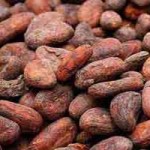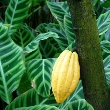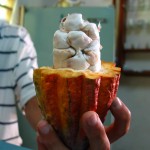Cocoa bean is the basis for the world’s most loved flavour – Chocolate – so its origins and a bit about its science is not only interesting but also has some general lessons on the importance of understanding traditional methods of primary crop treatment. The ways in which many crops are harvested and treated immediately post harvest is often important to their value and utility and is often poorly understood.
This piece focuses on flavour (and almost equally the reasons for some of off flavours) of Cocoa, but a related and interesting issue is the ability of the Cocoa to become red in tone when treated with alkali. This is important for industries which use Cocoa in bakery and beverage products and they in turn are important in absorbing the excess Cocoa powder arising from Chocolate production – Chocolate contains proportionately much more Cocoa fat than do Cocoa beans. Furthermore, the anthrocyanins in Cocoa which give this “red potential” have recently become the focus of attention as potentially beneficial antioxidants and Chocolate products using this as a basis for health claims are starting to appear.
 The Cocoa tree converts a huge amount of energy from sunlight to chemical energy in the form of fat, each tree producing about a kilogramme of cocoa butter in a typical season. For this reason it only grows well between the tropics and in environments where there is high rainfall and suitable soil quality. The trees are relatively small (up to about 3m high) and the flowers and therefore the pods grow directly on the trunk of the trees, with pods taking about three months to mature.
The Cocoa tree converts a huge amount of energy from sunlight to chemical energy in the form of fat, each tree producing about a kilogramme of cocoa butter in a typical season. For this reason it only grows well between the tropics and in environments where there is high rainfall and suitable soil quality. The trees are relatively small (up to about 3m high) and the flowers and therefore the pods grow directly on the trunk of the trees, with pods taking about three months to mature.
As a result of the climate in which it thrives Cocoa is vulnerable to insect and biological attack. The crop has to be monitored and sprayed regularly against pests, raising the cost of production for farmers and plantations yet Cocoa still suffers from higher losses from disease and infestation than almost any other crop. Partly as a result of this but also because of labour costs, Cocoa production has become uneconomic in some areas which were previously major producers – for example Brazil was for many years a major producer and now imports most of its Cocoa because of disease. Organic Cocoa production on a large scale is a real challenge and although good plantation husbandry can help there is really no “organic” answer to the major diseases.
Cocoa originated in South America but is now grown throughout the tropical regions, with the largest tonnages coming from West Africa. Whilst good quality “bulk” Cocoas are produced in Ghana, Nigeria and Cote d’Ivoire smaller tonnages of Cocoas with unusual flavour profiles due to unusual primary processing techniques are produced in South America and some other locations. These are most often used in blends of beans which characterise the flavour of some branded products although “origin” chocolates have recently become more common.
The commercial base of Cocoa for Europe has always been West Africa where particularly in Ghana and Nigeria it is essentially a social crop – harvesting and processing methods are determined by the social life of the village.
Traditional processes in those countries have given rise to the preferred Ghana/Nigeria flavour completely by accident, if someone had first cultivated and grown Cocoa on estates in the Far East, then the preferred flavour of Cocoa and Chocolate in Europe would be quite different. For similar reasons Cocoas from South America have long been used in North America and have influenced what is perceived as “typical” flavour in that location. Surprisingly the differences in flavour profiles from different locations are not caused mainly by fundamental differences in the bean on the tree (although there are some differences between Criollo and Forestaro Cocoas). Cocoa flavour is heavily influenced by the way in which the Cocoa is harvested and subsequently processed to produce dry bean. This gives an interesting insight into how important primary processing is to the quality of many crops. Tea, coffee and vanilla are amongst other well known crops where primary processing has a critical effect on flavour.
Taking Cocoa from the tree and simply drying it will give a product with little if any Cocoa flavour, it has to be fermented to develop the familiar flavour of Cocoa. In addition to fermentation there are several other steps in the processing of raw Cocoa which influence both the strength and the character of the flavour of the end product.
When split, cocoa pods contain about 60 raw beans which are surrounded by a sugary pulp. Fermentation by natural yeasts removes this and produces heat and acid within the bean, developing flavour and killing the bean. The bean is then dried to produce a stable product.
When split, cocoa pods contain about 60 raw beans which are surrounded by a sugary pulp. Fermentation by natural yeasts removes this and produces heat and acid within the bean, developing flavour and killing the bean. The bean is then dried to produce a stable product.
The process used in West Africa for converting wet raw bean into dry Cocoa was never established deliberately, it arose from a convenient and socially orientated method of processing which suited the environment in Ghana. In other countries where Cocoa is grown in a different environment apparently slight variations to this process have significant effects on flavour. A major study in the Far East allowed some of these factors to be identified
| West Africa Smallholder | Far Eastern Plantation |
| Pods picked individually when fully ripe. Fully ripe pods result in better flavour | Pods of a range of ripeness picked on a campaign basis |
| Pods stored until sufficient to split and make up a ferment. This storage period has a significant effect on flavour | Pods are all split immediately. The quantity involved appears to make storage impractical |
| Beans are fermented for about 5 days in small heaps | Beans are fermented in boxes for longer periods and frequently develop off flavours |
| Fermented beans are dried in the sun with frequent agitation. This process takes several days | Beans are dried quickly using hot air. Difference in drying has critical effects on quality |
Although a number of stages of the process are important drying is the most readily explained. One of the most significant problems experienced with Cocoas is excessive acidity and extended fermentation is one of the ways in which an attempt is made to reduce this (others include pressing and washing raw bean to reduce the amount of pulp). However, when a freshly fermented Cocoa bean is cut open it contains a strongly acidic purple coloured liquid, and longer fermentation does nothing to reduce this acidity. Rather it is removal of the acid in the drying process which controls final acidity.
The essential difference between sun drying and hot air drying is that in sun drying the shell of the bean remains hydrated until late in the process whereas with artificial drying the shell is dehydrated rapidly. Retaining hydration of the shell has two important effects. First the liquid phase inside the bean migrates to the surface by liquid phase diffusion which means that non volatile compounds such as acids are rapidly removed from the bean. If the shell dries rapidly, vapour phase diffusion is takes place and consequently acids are not removed from the bean and the resulting Cocoa will be acidic. Another important effect is that the hydrated shell will delay the ingress of air into the bean until late in the drying process thus reducing the degree of oxidation of the anthrocyanins.
These and other insights have allowed “West African” flavour Cocoa to be produced in other locations, particularly the Far East, but in most situations commercial factors have prevented the practice from being widely adopted. However the science and technology behind the work is of value not just in the context of cocoa but also in demonstrating the importance of a proper understanding of the science behind traditional primary processing techniques
It would be regrettable if the diversity of cocoa and other similar crops was to be lost and that is extremely unlikely given the fractured and localised nature of Cocoa production even within individual countries. Cocoas with different flavour characteristics have an important place in confectionery as they allow companies to produce products which are unique to them in the same way that different coffees and teas give important individual identities to brands and products. Another benefit of understanding these and other primary processing techniques more thoroughly is the ability to eliminate flavours agreed to be undesirable and to switch major production centres long term in the event of disease, pests, political instability or even climate change significantly reducing the ability of one area to produce major tonnages in the traditional manner.




